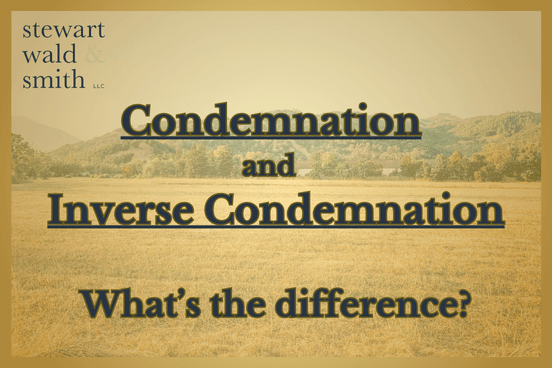Condemnation and Inverse Condemnation: What You Need to Know
Condemnation and Inverse Condemnation

By: Michael Smith
Condemnation: The Straightforward Approach
When people hear about the government taking property for public use, it typically comes from a clear announcement of the government’s intentions. For example, imagine the government wants to widen a road and needs a strip of your land to do so. Here is how it should proceed:
1. NOTIFICATION: The government provides notice to you that it plans to take a strip of land at the edge of your property to widen a roadway.
2. ACKNOWLEDGMENT OF PAYMENT: Implied in that notice is the government’s acknowledgement that it must pay you for what it will take – the market value of the strip of land.
3. NEGOTIATION: Because payment is required, the two parties – you and the government – work to reach an agreement on the market value of the land taken.
4. RESOLUTION: If you reach an agreement, great! But if you do not, and the government still fully intends to widen the road using your land, then the government may take you to court to have either a judge or a jury confirm the right to take your land and, if confirmed, decide the market value of the land taken.
This process is known as direct condemnation or eminent domain, and it is based on a right all governments have – the right to take property for public use. However, governments can only use that right when it pays a landowner the full market value of their taken property. In direct condemnations, the government recognizes that requirement at the beginning of the process, provides notice that it will take your property, and takes active steps to compensate you for your taken property.
Inverse Condemnation: The Landowner’s Challenge
But what if the government does not provide notice to you that it is taking your property or even acknowledges it owes you for that land? In fact, in some cases, the government outright denies it owes you anything for your taken property rights, usually because either the government believes it hasn’t taken anything at all or it hasn’t taken the time to find out. This situation is a bit more complicated. Here is how it might proceed:
1. UNANNOUNCED ACTIONS: The government acts in a way that uses or damages your property without providing notice or compensation for that use or damage. For example, converting old railroad tracks into public trails without letting you or the other adjacent landowners know about your property rights to that land. Learn more about this in our blog: Understanding Ownership: The Complex Reality Behind Railroad Rights-of-Way.
2. DENIAL OF LOSS or DENIAL OF LIABILITY: The government denies that you own the property used or damaged through its actions or denies its actions caused you any damage or loss at all.
3. FILING A LAWSUIT: In these situations, it may become necessary for you to file a lawsuit against the government to prove the government did indeed take your land and that it accordingly owes you compensation in the amount of the market value of the taken land.
Example: Rails-to-Trails
A common example of inverse condemnation involves the “rails-to-trails” program. In this program, the government authorizes old railroad rights-of-way for conversion into public trails. The federal government’s authorization for trail use prevents the land within the former railroad corridor from reverting to the adjacent landowner, which would have happened absent the government’s action. Because the government prevents that land from going back to adjacent landowners, the government effectively and permanently takes the land for public use as a trail, and the government accordingly owes the landowners the full value of their land within the corridor. Learn more about this in our blog, The Landowners’ Guide to the Trails Act.
However, in these situations, the federal government fails to provide any notice to the landowner that the government’s actions took the landowner’s property rights, and a lawsuit becomes necessary. This process is called an inverse condemnation because it is the landowner that must bring suit and affirmatively prove that the government’s actions resulted in a taking of property, rather than the government affirmatively recognizing the impact of its actions and proactively making the landowner whole.
If the landowner succeeds in proving they own the land in the corridor, and the government did indeed take their land, the action proceeds somewhat along the same route as a direct condemnation. The landowner and the government can either agree on the market value of the property – which is often easier said than done – or the parties ask the Judge to make the decision. The key difference is the extra effort and the extra steps to prove the government actually owes the landowner for taken property rights, which is where a rails-to-trails law firm like Stewart, Wald, & Smith comes in.
SWS has a lengthy and successful track record of both proving the federal government owes landowners money damages in rails-to-trails takings and obtaining market value for those takings all across the country. To learn more about inverse condemnations or rails-to-trails lawsuits more specifically, please contact SWS for a no-obligation consultation.

Did you receive our mailer, or have any questions for us? We’re here to help you take the next step for just compensation.
Notable Success Examples
-
In Haggart v. United States, our attorneys recovered $177,400,000 on behalf of 254 landowners in King County, Washington, along a 25.45-mile trail.
-
In Raulerson v. United States, our attorneys recovered $33,300,000 on behalf of 264 landowners in Beaufort County, South Carolina, along a 25.05-mile trail.
-
In Smith v. United States, our attorneys recovered $26,477,000 on behalf of 29 landowners in King County, Washington, along a 25.45-mile trail.
-
In Ansley Walk v. United States, our attorneys recovered $18,416,000 on behalf of 5 landowners in Fulton County, Georgia, along a 1-mile trail.
-
In Furlong v. United States, our attorneys recovered $14,200,000 on behalf of 272 landowners in Albany, New York, along a 10.94-mile trail.
